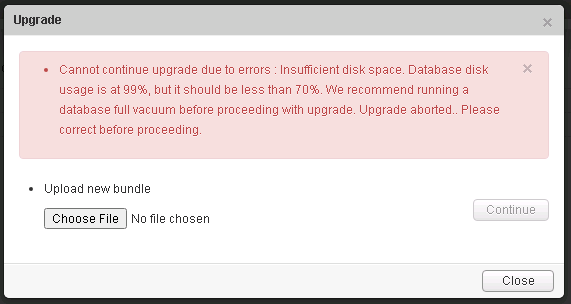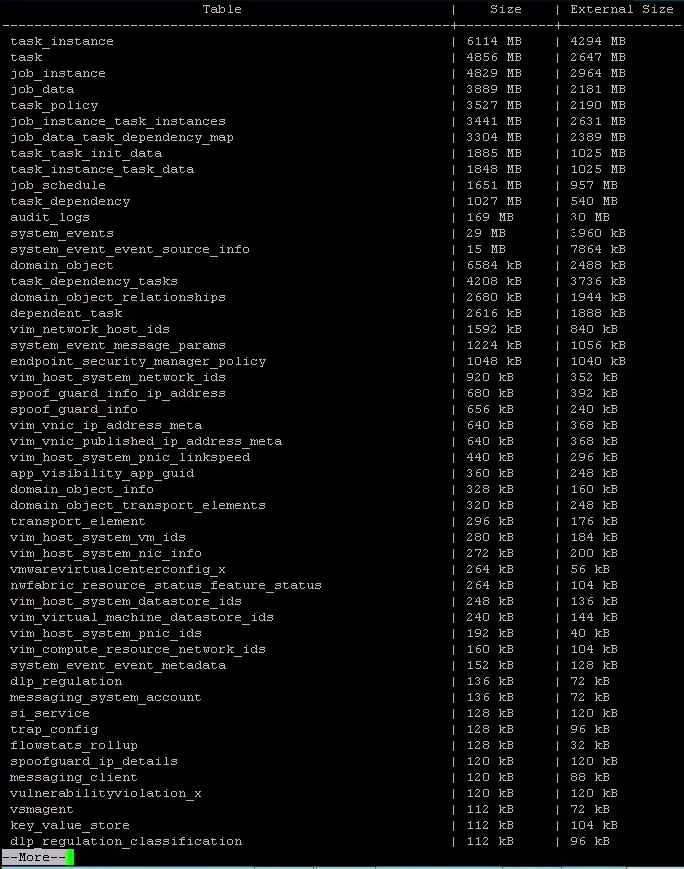Table of Contents
- Table of Contents
- Summary
- Warning
- Error outputs
- Create restore points
- Gaining root access
- Confirming Disk Space
- Fixing the underlying issues
Summary
When upgrading NSX manager you might encounter an error for ‘large database table’ or ‘insufficient disk space’ or ‘database disk usage’. These errors can either be because the log directory in /common/logs is full or you actually have a valid database full problem.
Warning
If you do not understand these commands nor have experience with database work then I highly suggest creating an SR with VMware and letting them work with you.
Error outputs
Even though we receive two different errors the resolution for the errors is actually the same procedure.
Error 1: Cannot continue upgrade due to errors : Insufficient disk space. Database disk usage is at 99%, but it should be less than 70%. We recommend running a database full vacuum before proceeding with upgrade. Upgrade aborted.. Please correct before proceeding.
Error 2: Cannot continue upgrade due to errors : Large database table. There are some tables with 5138984 entries, but the recommended table size is 5000000. We recommend running a database full vacuum before proceeding with upgrade. Upgrade aborted.. Please correct b

Create restore points
Whenever we work with the database and/or file system it is always recommended that we backup the NSX manager. There is two approved methods to do this:
- Create a VAMI backup of the NSX manager.
- Create a clone of the NSX Manager.
NOTE: Having a snapshot is not supported by VMware as a restore point.
Gaining root access
Getting into full root access on the NSX manager appliance is not an obvious process. We will want to SSH into the appliance which gets us initial access, from there we will need to switch to enable mode and finally get to engineering mode.
- Log into the NSX manager appliance via SSH.
- Switch to enable mode by typing:
enable - Enter the password, which by default is ‘default’
default - Enter into engineering mode
st eng - You will be asked if you are willing to accept responsibility, enter ‘Y’ and then enter the password.
IAmOnThePhoneWithTechSupport
Confirming Disk Space
- Examine the space left on the file system by executing ‘df -h’
[root@nsx-01 /]# df -h Filesystem Size Used Avail Use% Mounted on /dev/root 5.6G 2.1G 3.2G 40% / devtmpfs 7.9G 0 7.9G 0% /dev tmpfs 7.9G 460K 7.9G 1% /run /dev/sda6 44G 42G 371M 100% /common - Confirm where the disk space is being consumed in /common by running ‘du -h’
[root@nsx-01 /]# du -h /common/ 16K /common/lost+found 16K /common/lost+found 4.0K /common/dumps 4.0K /common/em/components/sem 1.9G /common/em/components/vdn 4.0K /common/em/components/xml 4.0K /common/em/components/vdb 19M /common/em/components/offline-bundles 368M /common/em/components/usvm 153M /common/em/components/edge 76M /common/em/components/epsec 509M /common/em/components/image 8.0K /common/em/components/metadata 3.0G /common/em/components 163M /common/em/downloads/edge/trinity 163M /common/em/downloads/edge 567M /common/em/downloads/image 76M /common/em/downloads/epsec 9.4M /common/em/downloads/offline-bundles 1.1G /common/em/downloads/vdn 389M /common/em/downloads/usvm 12K /common/em/downloads/snmp 8.0K /common/em/downloads/metadata 2.3G /common/em/downloads 28K /common/em/upgrade/logs 36K /common/em/upgrade 18M /common/em/backup 5.3G /common/em 128K /common/tmp 16K /common/auto 116K /common/work 4.0K /common/logs 4.0K /common/etc 8.0K /common/kernel_core 80K /common/configs 8.0K /common/secureall 36K /common/images 4.0K /common/db/vshield/pg_xlog/archive_status 81M /common/db/vshield/pg_xlog 508K /common/db/vshield/global 33M /common/db/vshield/pg_clog 4.0K /common/db/vshield/pg_commit_ts 4.0K /common/db/vshield/pg_dynshmem 12K /common/db/vshield/pg_notify 4.0K /common/db/vshield/pg_serial 4.0K /common/db/vshield/pg_snapshots 112K /common/db/vshield/pg_subtrans 4.0K /common/db/vshield/pg_twophase 1.9M /common/db/vshield/pg_multixact/members 744K /common/db/vshield/pg_multixact/offsets 2.6M /common/db/vshield/pg_multixact 7.0M /common/db/vshield/base/1 7.0M /common/db/vshield/base/12451 7.0M /common/db/vshield/base/12452 36G /common/db/vshield/base/16384 4.0K /common/db/vshield/base/pgsql_tmp 36G /common/db/vshield/base 4.0K /common/db/vshield/pg_replslot 4.0K /common/db/vshield/pg_tblspc 4.0K /common/db/vshield/pg_stat 440K /common/db/vshield/pg_stat_tmp 4.0K /common/db/vshield/pg_logical/snapshots 4.0K /common/db/vshield/pg_logical/mappings 12K /common/db/vshield/pg_logical 36G /common/db/vshield 452K /common/db/monitor/PG_9.6_201608131/16384 456K /common/db/monitor/PG_9.6_201608131 460K /common/db/monitor 12K /common/db/snmp 36G /common/db 12K /common/vsmvam/configs 24K /common/vsmvam 12K /common/replicator/configs 24K /common/replicator 3.2M /common/rabbitmq 42G /common/ - Alternatively the disk space could be showing fine but you still could be getting the second error from above and there is plenty of disk space.
[root@nsx-01 /]# df -h Filesystem Size Used Avail Use% Mounted on /dev/root 5.6G 2.4G 3.0G 45% / devtmpfs 7.9G 0 7.9G 0% /dev tmpfs 7.9G 456K 7.9G 1% /run /dev/sda6 44G 21G 21G 50% /common - An alternative command you can run that will find files larger than 1MB would be:
find / -xedv -type f -size +1M -exec ls -lh {} \; 2> /dev/null | awk '{ print $NF ": " $5 }' | sort -n -k2 -r
Fixing the underlying issues
- Confirm the status of the NSX manager services.
/etc/rc.d/init.d/bluelane-manager status Output: STARTED - Now we will want to stop the NSX Manager service. This process will take a few seconds.
/etc/rc.d/init.d/bluelane-manager stop Output: Stopping VMware NSX Enterprise Manager... VMware NSX Enterprise Manager stopped. - Access postgres to manipulate the database, this should get you into the ‘secureall’ prompt.
psql -U secureall
- Let’s enable expanded display.
\x - Now we will execute a command that will display our page sizes in our database, ordered by the total relation size.
select relname as "Table", pg_size_pretty(pg_total_relation_size(relid)) As "Size", pg_size_pretty(pg_total_relation_size(relid) - pg_relation_size(relid)) as "External Size" from pg_catalog.pg_statio_user_tables ORDER BY pg_total_relation_size(relid) DESC;
- For Error 2 above we need to get a count from task_instance.
select count(*) from task_instance ; Output: -[ RECORD 1 ]-- count | 5181456
- We will now want to vacuum the tables that we know from VMware are safe to do so on.
TRUNCATE TABLE job_instance_task_instances, ta sk_instance_task_data,task_instance_task_output,task_instance,task_task_init_data,task ,task_policy ,task_target, job_instance_job_output, job_instance, job_data_task_dependency_map, task_dependency_tasks,dependent_task,job_data,job_schedule,task_dependency,housekeeping_module; Output: TRUNCATE TABLE
NOTE: Do NOT vacuum anything unless you are for certain if it can safely be cleaned up.
- For Error 2 above we need confirm the count for task_instance has decreased.
select count(*) from task_instance ; Output: count ----- 0
- Now we need to quit out of the secureall prompt
\q - Now lets look at the disk space and see if we have recovered enough.
[root@nsx-01 /]# df -h Filesystem Size Used Avail Use% Mounted on /dev/root 5.6G 2.0G 3.4G 38% / devtmpfs 7.9G 0 7.9G 0% /dev tmpfs 7.9G 448K 7.9G 1% /run /dev/sda6 44G 5.7G 36G 14% /common - Finally we restart the NSX manager service
/etc/rc.d/init.d/bluelane-manager start Output: Starting VMware NSX Enterprise Manager... RabbitMQ Server is running. pg_ctl: server is running (PID: 3599) /top/vmware/vpostgres/9.6/bin/postgres "-D" "/common/db/vshield" Setting the NSX Manager IP 10.10.10.10
Massive thanks to Wilmer at VMware NSX technical support for how to perform this work!
Reference on how to gain root access: http://www.vsam.pro/how-to-get-fully-root-access-to-nsx-v-appliances-manager-edge-nsx-intelligence/